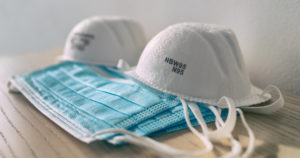How To Make A Protective Mask
April 8, 2020 In order to slow the spread of the Coronavirus and prevent hospitals from becoming overrun with critical cases, the Centers for Disease Control and Prevention (CDC) now recommends that most people wear a protective mask or face covering. The CDC recommends people wear them in spaces where social distancing is tough to maintain, like at the grocery store, in group settings, and on public transportation.
In order to slow the spread of the Coronavirus and prevent hospitals from becoming overrun with critical cases, the Centers for Disease Control and Prevention (CDC) now recommends that most people wear a protective mask or face covering. The CDC recommends people wear them in spaces where social distancing is tough to maintain, like at the grocery store, in group settings, and on public transportation.
COVID-19 is a highly contagious respiratory illness that is most often transmitted through respiratory droplets, or the liquid produced by an infected person through their coughs and/or sneezes. The virus can pass on through normal speech and a person’s exhalations. The CDC reports that the virus spreads more easily when people are in close proximity to one another and notes that data shows that people are not covering their coughs and sneezes effectively enough to prevent transmission. In order to slow the virus down, the CDC is now recommending that the general public wear mouth coverings and masks in certain social scenarios. Luckily, making a mask at home is fast and easy – and in most cases, people already have all the items they need and can avoid a trip to the store.
The CDC is calling COVID-19 a “stealth virus,” or one that spreads sneakily between people and across populations. According to a recent study, as many as 10% of new cases are attributable to pre-symptomatic spread, which is just one of the reasons it is important to fight back against growing transmission rates. People can be contagious and spread the virus for up to 3 days without experiencing any symptoms. Moreover, in some cases the common symptoms like fever, shortness of breath, and cough are mild and difficult to recognize in individuals who are ill. It is still most critical to wash your hands regularly and to socially distance and avoid going out as much as possible, but wearing a mask is an additional step that both healthy and sick people can take to limit potentially dangerous contact with others.
Making a Homemade Mask
The CDC says that all homemade face coverings should:
- Be secured with ties or ear loops,
- Fit snuggly but comfortably against the sides of the face,
- Include multiple layers of fabric,
- Allow for unrestricted breathing, and:
- Be able to wash and machine dry without damage to the fabric or shape
Face coverings should NOT be put on children under 2-years-old or on anyone who has breathing difficulties or is unconscious, incapacitated, or otherwise unable to remove the mask without outside assistance.
Sew Method
There are two main ways to make homemade face coverings: with or without sewing. To view step-by-step instructions for making Sew and No-Sew facemasks, visit theses resources from the Centers for Disease Control and Prevention or the City of Philadelphia.
Here are the steps for making a facemask with a sewing machine:
- Cut two 10-by-6 inch rectangles of clean (machine washed and dried) cotton fabric (like quilting fabric, cotton sheets, or T-shirt fabric.) Stack the two pieces of fabric on top of each other as if it was a single piece.
- Fold over the long sides ¼ inch and hem. Next, fold the double layer of fabric over ½ inch along the short sides, and stitch down.
- Run 6 inches of the 1/8-inch wide elastic through the wider hem on each side of the mask as ear loops. You can use a large needle or pin to thread the elastic through the hem. Then, tie the ends tight, and:
- Pull on the elastic gently so the knots are inside the hem. After gathering the sides of the mask on the elastic and adjusting it so that it fits your face, securely stitch the elastic to keep it from slipping.
No Sew Method
To make a mask with a no sew method, you will simply need a bandana or some other type of cotton cloth that is approximately 20 inches-by-20 inches, hair ties or rubber bands, a coffee filter, and scissors (in case you need to cut the cloth to size). Cut the top inch or two (the rounded edge) off the coffee filter and put it to the side. Fold the bandana or fabric in half horizontally, and then place the filter in the center of the cloth. Fold the top of the bandana down over the filter, and the bottom of the bandana up so that it is completely covered. Next, place rubber bands or hair ties about 3-4 inches in from the outside of the bandana on either side. Fold the sides to the middle and tuck, then flip the mask over to wear.
For information on how Pennsylvania residents are being affected by the coronavirus, visit: To stay up to date with important health and safety updates for residents in the state of Pennsylvania, please visit this link.
Philadelphia Personal Injury Lawyers at Galfand Berger, LLP Representing Injured Individuals Since 1947
If you have a legal question or concern, please contact our Philadelphia personal injury attorneys. With offices located in Philadelphia, Bethlehem, Lancaster, and Reading, Galfand Berger serves clients throughout Pennsylvania and New Jersey. To schedule a consultation, call us at 800-222-8792 or complete our online contact form.
 Google Screened
Google Screened
